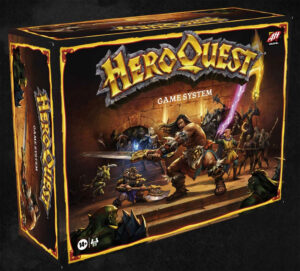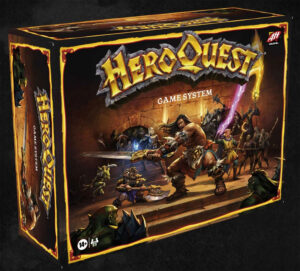 I can remember it like it was yesterday. The early 90s, me sitting down at the table behind my GM screen, ready to control the minions of Zargon. By now I’m sure most of you have heard of HeroQuest. Originally published in 1989, this is the granddaddy of the tabletop dungeon crawler game. Back then, it was amazing and inspiring.
I can remember it like it was yesterday. The early 90s, me sitting down at the table behind my GM screen, ready to control the minions of Zargon. By now I’m sure most of you have heard of HeroQuest. Originally published in 1989, this is the granddaddy of the tabletop dungeon crawler game. Back then, it was amazing and inspiring.
Fast forward to 2022, and publisher Hasbro has rereleased this long sought-after “Grail Game” thanks to their Hasbro Pulse crowdfunding platform. After 30+ years does the gameplay of this dice chucker still hold up? Let’s find out.
Gameplay Overview:
HeroQuest is a semi-cooperative board game where one player controls the minions of the evil wizard Zargon, while the other players (up to 4) control a team of iconic heroes. Barbarian, Wizard, Elf, and Dwarf are your options as players delve into the dungeon.

HeroQuest is a scenario-driven game, with some brief upgrading between missions. The basic round structure has each hero player taking a turn, followed by a turn for the Zargon player. On a player’s turn, they can both move and take an action. Movement is handled by rolling 2 6-sided dice, which are totaled up to your move value for the round (I hope you don’t roll snake eyes).
Either before or after your movement, your hero can take an action. These range from searching for traps, treasure, or secret doors, or fighting a monster/casting a spell.
Combat is handled via opposed dice rolls. The attacker rolls dice equal to their attack value, and the defender rolls dice equal to their defense value. Skulls are hits and shields cancel skulls. Most monsters have 1-3 hit points, and heroes have anywhere from 4 for the lowly wizard to 8 for the tough barbarian. Once a unit loses its last hit point, it is defeated.
The game ends when either all the heroes are defeated, or they achieve their mission goal and win.

Game Experience:
HeroQuest is a hard game for me to review. I try to go into every game with an open mind (objective reviews aren’t a thing people), but for me, it’s a giant nostalgia bomb. This game helped spark my love of fantasy gaming, dungeon crawls, playing DnD, and really just loving what board games could be. It’s been about 2 decades since I last played it, but I’ve got a lot of fond memories tied to this particular game.
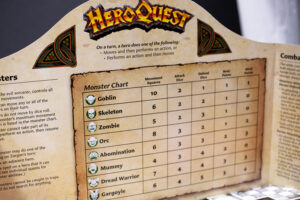
With that in mind, we need to see if the gameplay can still hold up after 30 years. And in the case of HeroQuest, it kind of does. Is it perfect? No. Has it been eclipsed by many other modern dungeon crawlers? Definitely. Despite all its flaws, it works surprisingly well, not only as an entry-level dungeon crawler, but as a game system.
If I were going to play a dungeon crawler tomorrow with my gaming group, HeroQuest wouldn’t be anywhere near the top of the ones I’d reach for. Chronicles of Drunagor, Descent, Tales from the Red Dragon Inn, and Kinfire Chronicles would all be ahead of it in the queue (among others). They just do so many things better. From having more modern rules, to a deeper experience, to better components, to fully cooperative gameplay (more on that in a bit), the dungeon crawler genre has come a long, long way since HeroQuest.

But as something to introduce to new players, or more likely, my kids, HeroQuest still has its place. The rules are very easy to learn, and the game takes literally no time at all to set up. The upgraded components (miniatures and terrain) look great, and give it some nice table presence. One of the greatest things about it though is that its works well as a game system. After you’ve played through the shortish campaign, you can easily make your own missions and quests. Takes a blank dungeon sheet, fill it out with some monsters and traps, and you are ready to go. Your only limit is Zargon’s imagination.
But let’s touch on those flaws for a minute. For those who haven’t experienced HeroQuest, you should know what you are in for. First of all, roll and move just sucks as a mechanic. It’s very random, often frustrating, and unnecessary in a modern game. The combat is very simple, and upgrading is somewhat rare in the game. Earning treasure is slow, and it can take multiple adventures to even get a new sword or helmet. But the real miss here is with the new integrated app. HeroQuest can now be played fully cooperatively (hurray!) or solo thanks to the app… but HeroQuest kind of sucks as an app-driven game.
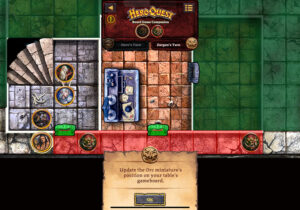
And don’t get me wrong, I love integrated apps in games: X-Com, Imperial Assault, Descent, Lord of the Rings: Journeys in Middle Earth, Mansions of Madness, I’m all in. But the difference is those apps enhance the game. The HeroQuest’s app just gets in the way. While it does a great job of controlling the bad guys, it requires just WAY too much input from the user. Every movement of your hero has to be tracked on the app. So you move your hero along a path in the app, and update its location. Then repeat for the next hero. The app then tells you which squares to move the monsters to on Zargons turn. While playing a solo game, I realized about halfway through that I was forgetting to update monster positions on the board. Just using the app to know where things were at. And as a trial, I played an entire game using just the app, the cards, and the dice. If your app can make 75% of the components unnecessary, then it’s probably doing too much.
But despite all that I still had fun with HeroQuest. Part of it was a nostalgia-fueled romp through the dungeons of my childhood (including the very same missions I remember playing), and the other part is just how easy it is to get to the table and chuck some dice. The intro text is about a paragraph long, and then it drops you in the action. The game board is set, so you don’t need to fish out tiles. Searching for traps and secret doors still feels a bit unique in this game, which leads to a nice sense of exploration. If you loved HeroQuest as a child, then you can have a lot of fun here.
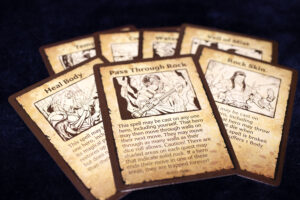
Finally, let’s talk about the heroes for a minute. I’m not sure if the heroes feel so vanilla because they aren’t very different from each other, or because they set the standard for dungeon-delving heroes way back in the day. But while most of the melee fighters are simply roll dice and hurt things the Wizard takes a pretty unique tack. He’s next to useless as a fighter (with one attack die and 4 hit points), but has a nice variety of spells: being able to allow a hero to walk through walls, heal someone, summon a genie to explore or fight, double someone’s speed, and of course, fire blasting spells. The downside is that once his nine spells are cast, he’s next to useless.
Final Thoughts:
If HeroQuest were a $40-$50 game, then I’d tell you to run out and buy it right now. Its gameplay still holds up (for the most part) after all this time. But with a $135 MSRP, I’m hard-pressed to recommend it to anyone who’s not going through nostalgia withdrawal. There are just SO MANY better dungeon crawlers available these days. Back in 1989, this would be a 5-star game. But in 2024, it’s really been eclipsed by other games.
But if you can find one at a reasonable price, it’s worth picking up. The best thing this reprint has done was kill the crazy secondhand market for the game, so if you want your kids to experience fighting the gargoyle-like you did as a child, you don’t have to shell out $300+.
I could probably spend another few thousand words talking about what I love and hate about HeroQuest, but I’m already way over my word count. For those curious to see what all the fuss is about, it’s definitely worth a play though. But I’m not sure everyone needs to own it today.
Final Score: 3.5 Stars – This is the game you played as a child, warts and all.
 Hits:
Hits:
• Works great as an entry-level dungeon crawler
• The game system lets you create your own missions
• Nice components and table presence
• All the good you remember from the 90s is still here
Misses:
• The app is way, way, way too intrusive
• Roll and move…bleh
• All the bad you remember from the 90s is still here.
Source: Board Game Quest



